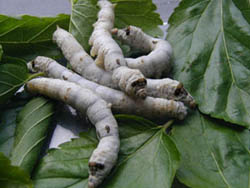
The silkworm (
Bombyx mori) is not a worm, but the larva of a moth. Being domesticated for silk production about 5,000 years ago, it is a well-studied lepidopteran model system, thanks to its rich repertoire of well characterized mutations affecting virtually every aspect of the organism's morphology, development, and behavior and its considerable economic importance.
Fresh progress has been made in the genetic studies of the silkworm in the teamwork of scientists from the CAS Beijing Genomics Institute, Southwest Agricultural University, James D. Watson Institute of Genome Sciences of Zhejiang University and the Genome Center of University of Washington in US.
The draft sequence for the silkworm genome, report the researchers, covers more than 90% of all known genes of the insect. The work is considered the most thorough genome sequence data so far for the silkworm, and published in the Dec. 10 issue of the journal
Science.
Based on their work on draft sequence of the silkworm, the researchers made a comparative analysis between this lepidopteran and their insect relatives whose genetic codes have previously been sequenced (fruitfly, mosquito, spider, and butterfly). They found that the silkworm genome is larger than that of Drosophila (about 13,000) because of increases in gene number and size.
Using BGI GeneFinder, a computer software they developed for the differentiation of the silkworm's genetic information, the researchers made an detailed analysis on the biological implications of a huge amount of genetic information. And for the first time, they have found some major functional genes related to the insect's gender control, growth and immunity.
The silk gland, essentially a modified salivary gland, is a highly specialized organ whose function is to synthesize silk proteins. Researchers identified a set of 1,874 annotated genes that are confirmed by silk gland expressed sequence tags. And about 97% of the genes are first discovered ones. In addition, they obtained convincing evidence on the hormone's activity in it.
Researchers also compared those 1,874 genes expressed in B. mori silk gland with all available spider data (1,482 from GenBank) and identified 107 homologous genes, including four B. mori counterparts for the major ampullate gland peroxidase in the spider, which is involved in silk fiber formation.
In the analysis of the gene sequences, the scientists brought to light a total of 87 neuropeptide hormones, hormone receptors and hormone-regulation genes. They also identified 18 EH-sensitive receptors and receptor-like transcription factors
Th studies on the genes and their functional analysis will remove bottlenecks in studying the cloning of related genes for silk protein synthesis, according to Prof. Xiang Zhonghuai, a well-known silkworm expert. A deep-going study on them will realize the artificial adjustment of the silkworm's growth and development, leading to the restructuring of the traditional industry so that sericulture will be able to serve human race in a more effective way.







